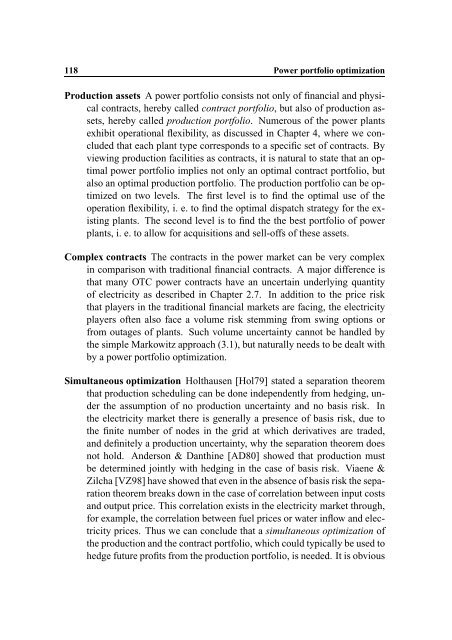Hedging Strategy and Electricity Contract Engineering - IFOR
Hedging Strategy and Electricity Contract Engineering - IFOR
Hedging Strategy and Electricity Contract Engineering - IFOR
Create successful ePaper yourself
Turn your PDF publications into a flip-book with our unique Google optimized e-Paper software.
118 Power portfolio optimization<br />
Production assets A power portfolio consists not only of financial <strong>and</strong> physical<br />
contracts, hereby called contract portfolio, but also of production assets,<br />
hereby called production portfolio. Numerous of the power plants<br />
exhibit operational flexibility, as discussed in Chapter 4, where we concluded<br />
that each plant type corresponds to a specific set of contracts. By<br />
viewing production facilities as contracts, it is natural to state that an optimal<br />
power portfolio implies not only an optimal contract portfolio, but<br />
also an optimal production portfolio. The production portfolio can be optimized<br />
on two levels. The first level is to find the optimal use of the<br />
operation flexibility, i. e. to find the optimal dispatch strategy for the existing<br />
plants. The second level is to find the the best portfolio of power<br />
plants, i. e. to allow for acquisitions <strong>and</strong> sell-offs of these assets.<br />
Complex contracts The contracts in the power market can be very complex<br />
in comparison with traditional financial contracts. A major difference is<br />
that many OTC power contracts have an uncertain underlying quantity<br />
of electricity as described in Chapter 2.7. In addition to the price risk<br />
that players in the traditional financial markets are facing, the electricity<br />
players often also face a volume risk stemming from swing options or<br />
from outages of plants. Such volume uncertainty cannot be h<strong>and</strong>led by<br />
the simple Markowitz approach (3.1), but naturally needs to be dealt with<br />
by a power portfolio optimization.<br />
Simultaneous optimization Holthausen [Hol79] stated a separation theorem<br />
that production scheduling can be done independently from hedging, under<br />
the assumption of no production uncertainty <strong>and</strong> no basis risk. In<br />
the electricity market there is generally a presence of basis risk, due to<br />
the finite number of nodes in the grid at which derivatives are traded,<br />
<strong>and</strong> definitely a production uncertainty, why the separation theorem does<br />
not hold. Anderson & Danthine [AD80] showed that production must<br />
be determined jointly with hedging in the case of basis risk. Viaene &<br />
Zilcha [VZ98] have showed that even in the absence of basis risk the separation<br />
theorem breaks down in the case of correlation between input costs<br />
<strong>and</strong> output price. This correlation exists in the electricity market through,<br />
for example, the correlation between fuel prices or water inflow <strong>and</strong> electricity<br />
prices. Thus we can conclude that a simultaneous optimization of<br />
the production <strong>and</strong> the contract portfolio, which could typically be used to<br />
hedge future profits from the production portfolio, is needed. It is obvious
















